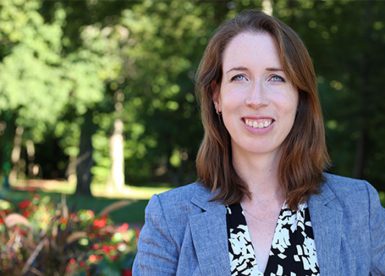Comfort presents research on advocacy journalism

When the U.S. economy declined in 2008, assistant professor Suzannah Evans Comfort had to make a career change.
Previously a newspaper journalist, Comfort moved into environmental advocacy and served as the editorial director for the magazine of Oceana, the world’s largest international ocean conservation organization.
“I had come from the newspaper world and moved into the advocacy world,” said Comfort, as she introduced her recent study, Theory of Journalism: A Journalistic Production by Environmental NGOs, at the Media School research colloquium Oct. 20. “And I had been indoctrinated with the idea that there’s only one true journalism. The one true journalism comes from one very specific type of source, which is a commercial newsroom filled with professional journalists, and anything else is public relations. So I always carried that with me, and I felt this sort of weird sense of shame that I worked for an advocacy organization.”
Those feelings stayed with Comfort for years. Like other journalism scholars, she avoided looking at advocacy journalism in her research, until her most recent study.
Comfort studied three of the largest U.S. environmental nongovernmental organizations — Audubon, Sierra Club and The Nature Conservancy — and interviewed some of the freelance reporters these organizations commissioned to write articles for their magazines.
“All of these groups have been publishing journalism in some form for over a century,” Comfort said. “And yet this production has totally escaped any notice by journalism scholars and social movement scholars. For whatever reason, the environmental press has just floated on by, so I saw a real opportunity there.”
Comfort examined the last three years’ worth of feature articles published by these organizations and interviewed 16 of the reporters who wrote them. In these interviews, she asked them about their experiences writing for the NGO and how they differed from writing for traditional media.
Most of the reporters Comfort interviewed were successful freelancers who are engaged with the world of traditional journalism. Demographically, Comfort found they were slightly more liberal and slightly less likely to have a journalism degree than average journalists.
To analyze the writing process of each of these journalists, Comfort asked them to select a story to talk about in-depth. Most reporters said the articles originated when the NGOs approached them to pitch the story.
The reporters also said there was a lot more oversight and control over what they were writing for the NGO compared to traditional journalism. One interviewee described it as a “curated reporting experience.” Although the reporters stressed their independence, many described an unspoken understanding that the journalism shouldn’t conflict too much with the NGO’s orientation.
“When the reporters went to the locations of their stories, they could interview whoever they wanted and use whatever quotes they wanted, but the NGO had already put their finger on the scale by giving them the sources,” Comfort said. “In many ways, the journalists were acting independently, but in other ways they were sort of being funneled into the story.”
All the writers interviewed reported a high adherence to accuracy, often finding more fact checking than normal on the part of the NGO. Questions of balance and objectivity, Comfort said, got more nuanced answers.
The interviewees didn’t reject balance entirely, but said that it wasn’t as important in their reporting for the NGO because it involved the environment. Many saw this as a black-and-white issue and didn’t have a problem with not amplifying dissenting voices as much as they would with other issues.
Many of the reporters Comfort interviewed didn’t consider issues of objectivity and transparency to be very important in this kind of reporting, because the given magazines had well-known, specific agendas.
“Here we see them stepping back from the way commercial newsroom reporters might say how they feel about objectivity,” Comfort said. “At the same time, this is also a function of the genre. Magazine reporting is more interpretive than newspaper reporting.”
Finally, Comfort wanted to know why these NGOs even bother with publishing magazines that ultimately lose the parent company money.
“The publications want ‘real journalism’; they want it to be a magazine story. They don’t want it to be public relations material,” Comfort said. “Publishing real journalism gives them more credibility, more of a sense of independence, and therefore, allows them to report on environmental issues in a way that’s more believable.”
In the future, Comfort would like to talk to editors of these publications, as well as traditional journalists who haven’t written for these advocacy groups, to more fully analyze the role of these magazines in the larger world of journalism.
More:

